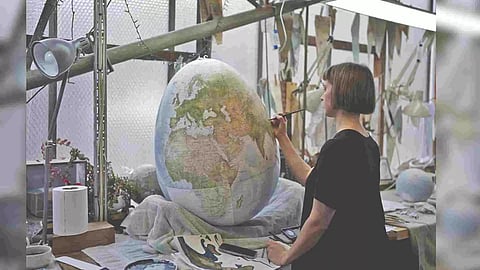

LAURIE KELLMAN
Find a globe in your local library or classroom and try this: Close the eyes, spin it and drop a finger randomly on its curved, glossy surface. You’re likely to pinpoint a spot in the water, which covers 71% of the planet. Maybe you’ll alight on a place you’ve never heard of — or a spot that no longer exists after a war or because of climate change. Perhaps you’ll feel inspired to find out who lives there and what it’s like. Trace the path of totality ahead of Monday’s solar eclipse. Look carefully, and you’ll find the cartouche — the globemaker’s signature — and the antipode (look it up) of where you’re standing right now.
In the age of Google Earth, watches that triangulate and cars with built-in GPS, there’s something about a globe — a spherical representation of the world in miniature — that somehow endures.
London globemaker Peter Bellerby thinks the human yearning to “find our place in the cosmos” has helped globes survive their original purpose — navigation — and the internet. He says it’s part of the reason he went into debt making a globe for his father’s 80th birthday in 2008. The experience helped inspire his company, and 16 years later is keeping his team of about two dozen artists, cartographers and woodworkers employed.
“You don’t go onto Google Earth to get inspired,” Bellerby says in his airy studio, surrounded by dozens of globes in various languages and states of completion. “A globe is very much something that connects you to the planet that we live on.” Or, as Scottish-born American explorer John Muir wrote in 1915: “When we contemplate the whole globe as one great dewdrop, striped and dotted with continents and islands, flying through space with other stars all singing and shining together as one, the whole universe appears as an infinite storm of beauty.”
Beyond the existential and historical appeal, earthly matters such as cost and geopolitics hover over globemaking. Bellerby says his company has experience with customs officials in regions with disputed borders such as India, China, North Africa and the Middle East.
And there is a real question about whether globes — especially handmade orbs — remain relevant as more than works of art and history for those who can afford them. They are snapshots of the past, of the way their patrons and makers saw the world at a certain point in time. So they’re inherently inaccurate representations of a planet in constant flux.
“Do globes play a relevant role in our time? If so, then in my opinion, this is due to their appearance as a three-dimensional body, the hard-to-control desire to turn them, and the attractiveness of their map image,” says Jan Mokre, vice president of the International Coronelli Society for the Study of Globes in Vienna. “Perhaps a certain nostalgia effect also plays a role, just as old cars and mechanical watches still exert a certain attraction on people.”
Joshua Nall, Director of the Whipple Museum of the History of Science in Cambridge, says a globe remains a display of “the learning, the erudition, the political interests of its owner.”